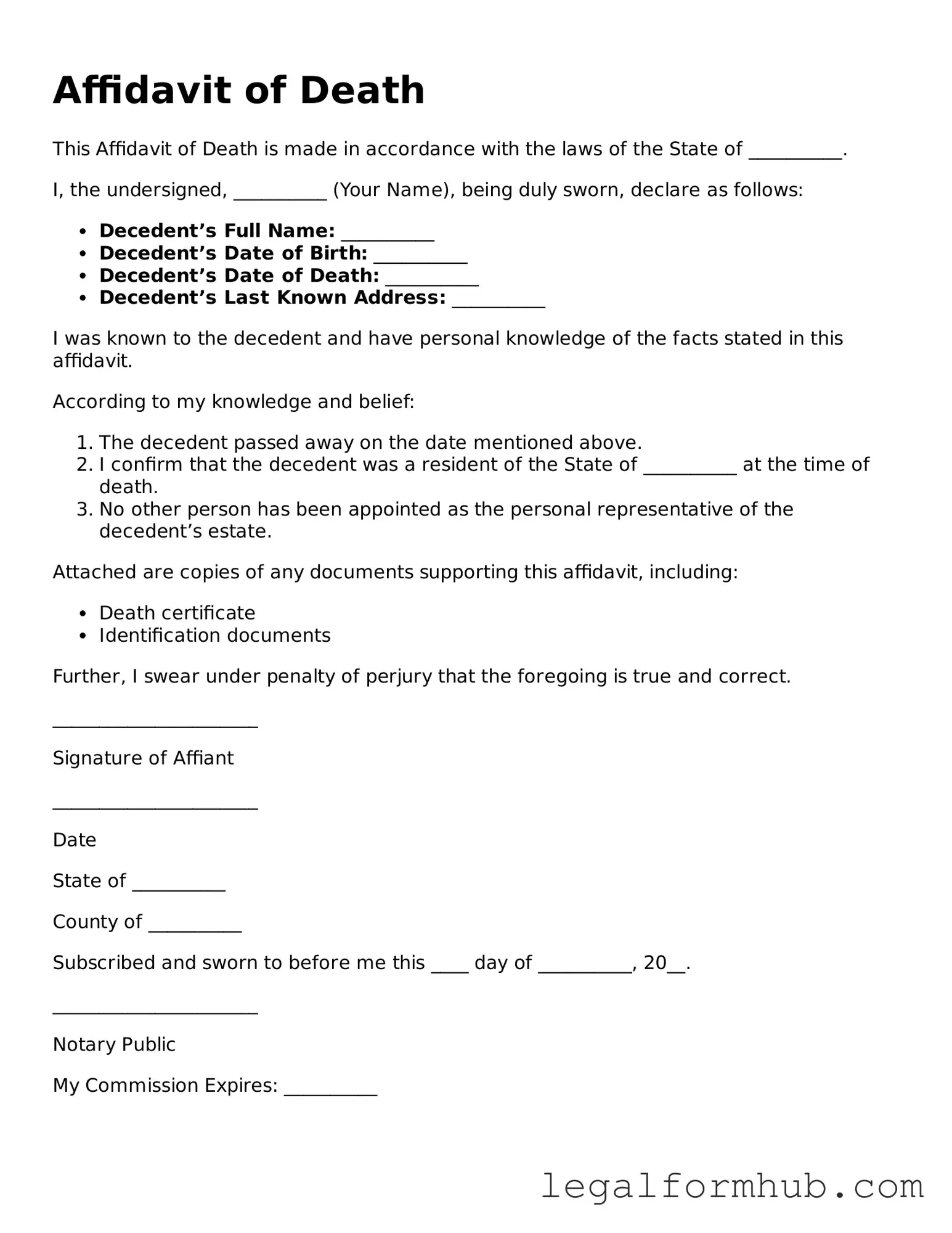The Affidavit of Death form is similar to a Last Will and Testament, which outlines an individual's wishes regarding the distribution of their estate after death. Both documents serve to clarify intentions and provide guidance to survivors. While the Affidavit of Death officially confirms a person's passing, the Last Will ensures that the deceased's assets are distributed according to their preferences, thereby preventing potential disputes among heirs.
Another document comparable to the Affidavit of Death is the Death Certificate. This official record, issued by a government authority, serves as legal proof of death. While the Affidavit of Death may be used in various legal contexts, the Death Certificate is often required for administrative tasks, such as settling estates or claiming life insurance benefits. Both documents are crucial in establishing the fact of death, but they serve different purposes in legal proceedings.
The Probate Petition is also similar to the Affidavit of Death. This document initiates the legal process of administering a deceased person's estate. In many cases, the Affidavit of Death may accompany the Probate Petition to confirm that the individual has indeed passed away. Both documents work together to facilitate the transfer of assets and ensure that the deceased's affairs are settled according to the law.
A Power of Attorney is another document that shares similarities with the Affidavit of Death. While the Affidavit confirms death, a Power of Attorney designates an individual to make decisions on behalf of another person while they are alive. If the person passes away, the Power of Attorney becomes void, and the Affidavit of Death may be required to transition authority to the executor or administrator of the estate. Both documents are essential in managing an individual's affairs, albeit at different stages of life.
The Living Will is also akin to the Affidavit of Death in that both deal with end-of-life matters. A Living Will outlines a person's preferences regarding medical treatment in the event they become incapacitated. While the Affidavit of Death confirms that a person has died, the Living Will provides guidance on their wishes prior to that point. Both documents emphasize the importance of personal choice and clarity regarding one's desires as they relate to life and death.
The Affidavit of Heirship serves to clarify the rightful heirs of a deceased person, especially when no will exists, and helps facilitate the transfer of assets smoothly. To ensure all necessary legal documentation is prepared correctly, it is essential to fill out related forms accurately; for example, you can visit Fill PDF Forms to access various templates that assist in managing estate-related matters and ensuring compliance with legal expectations.
The Certificate of Trust can be compared to the Affidavit of Death as both documents play a role in estate planning. A Certificate of Trust verifies the existence of a trust and identifies the trustee, while the Affidavit of Death serves to confirm the death of an individual. When a trust is involved, the Affidavit of Death may be necessary to facilitate the transfer of assets held in the trust, ensuring that the deceased's wishes are honored in accordance with the trust's terms.
The Declaration of Heirship is another document similar to the Affidavit of Death. This declaration is often used when a person dies without a will, establishing who the legal heirs are. The Affidavit of Death can support the Declaration by providing official confirmation of the individual's passing. Both documents aim to clarify the legal status of heirs and facilitate the distribution of the deceased's estate, particularly in cases where there is no clear testamentary directive.
The Letter of Administration is also comparable to the Affidavit of Death. This document is issued by a court to appoint an administrator to manage a deceased person's estate when there is no will. The Affidavit of Death is often required to accompany the Letter of Administration, serving as evidence that the individual has died. Together, these documents help ensure that the estate is managed and distributed according to legal requirements.
Finally, the Affidavit of Support can be seen as similar in its function of confirming a person's status, albeit in a different context. This document is often used in immigration cases to demonstrate that an individual can financially support another person. While it does not directly relate to death, both documents serve to affirm a person's circumstances and provide necessary information for legal processes. Each plays a crucial role in ensuring that legal requirements are met, whether in life or after death.
